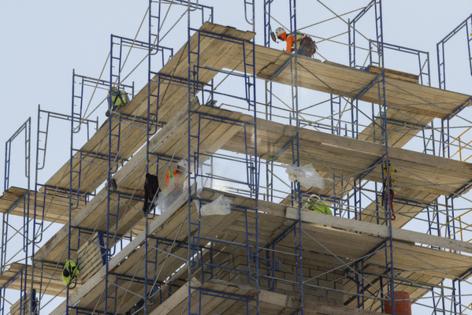Developers should build more apartments for families, study argues
Published in Business News
In the years since the Great Recession, apartment construction in the United States has boomed. And more of these new homes have been smaller units, with fewer bedrooms, including studio apartments.
A recent paper from the Institute for Family Studies, a nonprofit that focuses on strengthening marriage and family life, argues that developers are underserving a key segment of the market by continuing to overwhelmingly target apartments to households of roommates and families without children. And the authors argue that fertility rates could be boosted by diversifying the kind of units that get built.
While it made sense to construct smaller units to cater to financially strapped, later-to-marry millennials in the 2010s, the authors argue that developers have made a mistake by continuing to mostly cater to that kind of demographic.
“There was a surge in demand for apartments that were suitable for that stage of life, but the reality is that millennials are now settling down, getting married, and having kids,” said Lyman Stone, director of the institute’s Pronatalism Initiative and one of the coauthors of the paper. “We’ve got a situation where it made sense to build out a lot of smaller units, but now it should probably be half as frequent as it was five years ago.”
Stone and his coauthor, Bobby Fijan, a Philadelphia-based developer, don’t try to be too prescriptive about what makes a “family-friendly” apartment.
Often that term has meant three- or four-bedroom units where children could have their own rooms. But the authors instead make the case for a variety of apartment layouts, including one-bedrooms with dens and two-bedroom units that could be appropriate for people at different phases of family life.
In a 6,000-person survey they conducted, the open floor plan apartments that have become common and often lack additional bedrooms — or even a den that could house a crib — are found to pretty much appeal only to people without children.
“It is clear that the shift toward more open apartment layouts is uniquely tailored for the interests of childless people who don’t want kids,” the report reads.
They also find that apartments built in recent years are more likely to devote more square footage to bathrooms, in part to appeal to those renting with roommates, and larger closets in place of more bedrooms or other kinds of living areas.
Housing crisis and apartment boom
In the past, as people aged and families grew, they would often move out of apartments and into single-family homes — thus obviating the need for multifamily buildings that can accommodate households with children.
But in recent years, more Americans have been living longer in apartments. That’s partly because the millennial generation launched careers following the Great Recession, which depressed wage growth, savings and asset accumulation.
It’s also because regulatory barriers, especially in suburban areas, have made it harder to build new single-family homes even as older generations stay in larger-format houses long after their children have moved out.
All of this has likely contributed to more people marrying and having children later in life.
That’s why the authors argue that it is important to accommodate more types of households, with different unit layouts, in apartment buildings.
Fijan, the Philadelphia developer and coauthor, says that building a greater diversity of apartment types could also allow more households to stay in the city longer.
“Philadelphia is the kind of city that attracts a lot of young people to stay after college,” said Fijan, cofounder of the American Housing Corp.
“What we’re arguing is that you want some amount of product that captures more of them so they don’t automatically leave” when they start thinking about having children, Fijan said.
A pivot to larger apartments?
The authors say their findings are becoming visible in the apartment market. Studio apartments already have much higher vacancy rates than three-bedroom units, in part because they have a greater churn of tenants — which costs landlords more as they have to clean and repair empty apartments to attract new renters.
“When we shop our ideas around to developers and investors, a lot of them said, ‘Yeah, this is actually what we’ve observed, and we are already making this pivot,’ ” Stone said. “They’re already seeing in their own data that the studio units are problematic, that it’s actually better to have a mix of more, bigger units.”
But the real estate industry as a whole could be difficult to quickly convince. Builders and their financiers are extremely risk-avoidant, due to the large amounts of money involved and the industry’s inherent risk.
Investors want proof that their units will lease up reasonably quickly, and developers need to be able to charge rents that allow them to pay back their lenders.
As a result, developers try to compare their projects to existing counterparts to show that they will be able to get the rents their financiers want to see. That makes new designs, without exact comparisons in the market, have difficulty winning funding.
In Philadelphia, developers in the post-pandemic era have continued to build a preponderance of studio and one-bedroom apartments, but some movement toward different kinds of units is being seen.
“Many more recent apartment projects — including suburban ones — have been built for older millennials and Gen Zers who have been priced out of homeownership due to the sharp increases in housing unaffordability across our region,” said Kevin Gillen, an economist with Drexel University’s Lindy Institute for Urban Innovation.
But some of the companies that have been adding three-bedroom units to the market, like the Post Brothers, report slower than anticipated lease-up in those apartments.
Fijan says that’s why their paper calls for more experimentation not just with three- or four-bedroom units, but with different apartment formats that can accommodate families at different stages — even if they aren’t going to stay in the multifamily market while their children age up and go to school.
For that, Fijan says more experimentation is needed with smaller apartment buildings, which can be easier to finance and allow developers more flexibility. The larger a project gets, the more risk-averse lenders become.
The larger trends in the housing market’s unaffordability may continue to push in that direction anyway — especially as President Donald Trump’s tariffs start to hit.
“If this affordability problem persists, and households continue to age and grow in size, it would also be perfectly rational for developers to respond by building larger units with more bedrooms,” said Gillen, who is also an adviser on the board of the Building Industry Association, which represents residential developers in Philadelphia.
©2025 The Philadelphia Inquirer, LLC. Visit at inquirer.com. Distributed by Tribune Content Agency, LLC.












Comments